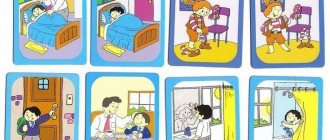Popular "Apple" method
To clearly explain to a child the duration of notes, you can give an example with an apple (or pie). Imagine a big juicy apple. It is as round as a whole note, which lasts longer than other durations. It is equal to four beats (or four claps). The whole note has no calm, and in the recording it looks like an apple transparent with juice (a circle that is not filled in).
If you divide the fruit in half, you get the following duration - half, or half. One whole note, like an apple, consists of two halves. The half stretches two beats (or two equal claps), looks like a whole, but at the same time it has a calm.
Now let's divide the apple into four equal parts - we get quarter durations or quarters (one quarter is equal to one share or one clap). There are four quarter notes in a whole note (hence their name), they are written as halves, only the “apple” now needs to be painted over:
A fruit cut into eight slices will introduce the child to the eighth or eighth (one share is two eighths). If there is only one eighth, then its stem has an additional tail (flag). And several eighths are combined under one roof (two or four pieces).
Additional recommendations
Tip 1. In parallel with the explanation, you can draw different durations in the album. It’s good if after such study the child remembers all the durations and their names.
Tip 2. If you study at home, then it is better to show all examples with a real apple or orange, and not with a drawn one. You can practice dividing not only on an apple, but also on a cake, pie or round pizza. This makes it possible to repeat the lesson several times (and when repeating, let the child explain everything himself).
Tip 3. You can ask your child to name the names of friends or family members with whom he will share an apple or pieces of cake. In this case, the cut pieces can be put back together in different combinations, asking the following questions: “What note value can be obtained if you put these pieces together” or “How many eighth (or quarter) notes fit in one half (or whole)”?
Tip 4. For constant exercise, you can cut out several circles from cardboard. The whole circle according to the “apple principle” symbolizes the whole note. The second circle can be folded in half and a half note drawn on each half. We divide the third circle into four parts and, accordingly, devote it to quarter notes, etc.
Let the children themselves draw the durations on the circle. It looks something like the figure below.
If you wish, you can download ready-made circle blanks with or without images from our website, print and cut them out.
MUSICAL CIRCLE PREPARATIONS –
Notes are like balloons!
Let's continue to fantasize! To visualize images of the main durations in a child’s mind, use the example of balloons. So, a whole note is a big white ball, while a half note will be a white ball on a string. A quarter is some kind of colored balloon on a string, and eights usually don’t go alone, so they can be thought of as several colored balloons connected to each other.
After a little training, you can examine the young musician. For this we need cards with different musical durations. We show the child the card, and let him name the duration that he sees.
We have already prepared cards for such purposes. You can print several sets of cards at once if you plan to continue using them in your work (for example, for rhythmic dictations). You may also find pause cards useful in the future. We provide a link to them as well.
“NOTE DURATION” CARDS –
PAUSE DURATION CARDS -
Recognizing beats and durations
Together with your child, clearly and clearly say out loud the rhyme about Andrew the Sparrow, clapping your hands for each syllable.
Have you noticed that some claps are shorter than others? Now sing the same counting rhyme on one note, combining singing with clapping. The result is a short song, where each musical sound has a certain duration.
Now we’ll do something similar, but we’ll only mark equal shares with claps.
It turned out that there are eight beats in the song, while the duration is eleven. And all because one beat contains two eighths. This is what the song looks like in musical notation:
Multi-colored ropes or candy wrappers
Multi-colored laces (ropes, threads), or even better, pieces of colored paper in the form of rectangles and squares of different sizes will help to put time indicators of durations in the baby’s head. Prepare the longest cord of yellow (or any other) color, it will be a whole note; the red lace is half as long - half. For a quarter, a green rope half the size of a half cord is suitable. Finally, the eighth is a very small blue lace.
Explain to your child what lengths the laces correspond to. Use simple sheet music examples: arrange their durations in strings in the correct order (you will need several identical blanks for the same duration).
For example, in the famous New Year's song “The Little Christmas Tree Is Cold in Winter” there are quarter notes, eighth notes and half notes. Here's how to lay out the rhythm of this song using colorful pieces of construction paper:






